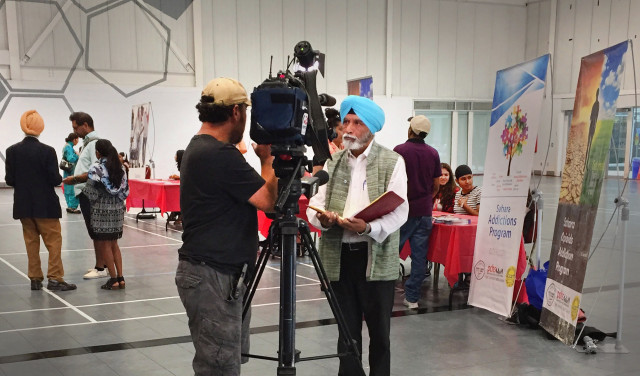The Impact of Ethnic Media on the Wellbeing and Integration of New Canadians
Baldev Mutta, founder of the Punjabi Community Health Services, speaks to ethnic media’s importance in helping immigrants settle into their new country.

Mr. Mutta being interviewed at PCHS
Immigrants in Canada dwell in two simultaneous states: their present state in a new country, which is full of challenges, aspirations, and struggles, and their past state from back home, full of relationships, history, and memories.
Ethnic media plays a critical role in keeping both states intact. Not only does it inform and entertain immigrants with news and stories from the places they emigrated from, but it helps them settle in their new home by giving them necessary information and guidance on how to navigate the landscape.
At the organization I run, Punjabi Community Health Services (PCHS), ethnic media has been vital in our attempts to reach the immigrant communities we work with. But ethnic media is struggling to survive. When our diverse ethnic newspapers and radio stations close, communities lose access to information they desperately need.
Stay informed, subscribe to the FRIENDS newsletter
You are a few fields away from becoming a friend.
In 1990, when PCHS started its work in Brampton, Ontario, the practice of emigrating from South Asia was different. Immigrants arrived in Canada without much knowledge of the country or of the settlement challenges awaiting them. Once they arrived, they often settled in “ethnic enclaves,” which nurtured a sense of belonging but were less helpful in facilitating civic and economic integration.
Back then, immigrants would look to their own community to find information on health, employment, settlement, and specialized services of urgent need, not to mention those that were socially and culturally unique to them. The most relied-upon channel of communication was word of mouth, partly due to South Asian oral tradition, but also due to literacy and language barriers. While word of mouth was effective, it was fraught with factual inaccuracies.
When our diverse ethnic newspapers and radio stations close, communities lose access to information they desperately need.
In the lead up to PCHS’s inception, the organization’s founding members had identified two major challenges faced by South Asian immigrant populations. One: the lack of access to authentic and accurate information needed for employment, housing, health, and legal services. Two: a cultural blindness in the information that was available from social service agencies and municipalities, where the aspects of cultural competence and equity were missing.
PCHS was started as a way to fill the gap and began offering group activities to talk about stigmatized social issues like mental health, addictions, domestic violence, elder abuse, intra-family toxic communications, isolation of women from the economic and social realm, and various issues facing vulnerable youth. The discussions, reflections, and deliberations in these groups led to more authentic, accurate, and sound information for the immigrant community than word of mouth had done.
In an attempt to reach more participants, PCHS printed pamphlets and brochures in local languages, which contained evidence-based information from credible sources. However, seeing that most of the community members had a passive relationship with the written word because of their deeply embedded oral tradition, PCHS decided to turn to ethnic media.
To reach more people with its programming, representatives from PCHS started appearing on Punjabi TV programs. Eventually, looking for more creative control—and despite the fact that not many mainstream funders were willing to support the production of broadcast content—PCHS opted to produce its own content and have it disseminated through already existing ethnic media radio and TV channels.
Ethnic media contributes to their sense of being and belonging in Canada as much as early childhood education does to a child’s civic sense.
There is a catch to this, though. The fundamental principle of not-for-profit organizations is to inform, engage, mobilize, and change the community in which they work and live. However, ethnic media doesn’t necessarily share the same ethos—not because they don’t subscribe to this social transformation path, but because they don’t believe this educational content will lead to advertising revenue, which they need to survive. And as long as ethnic media relies on this kind of revenue, it will get more and more difficult to secure space on their channels and reach the immigrant population who benefit from our services.
There are thousands of South Asians in the Greater Toronto Area who benefit daily from news, views, and entertainment aired by ethnic radio, TV channels, newspapers, and magazines. Ethnic media contributes to their sense of being and belonging in Canada as much as early childhood education does to a child’s civic sense.
We need to ensure ethnic media is supported so that it can play its role most effectively. The first step is to appreciate its impact in the media landscape. Understanding it as a necessary instrument in helping immigrants become Canadians will help us get there.
